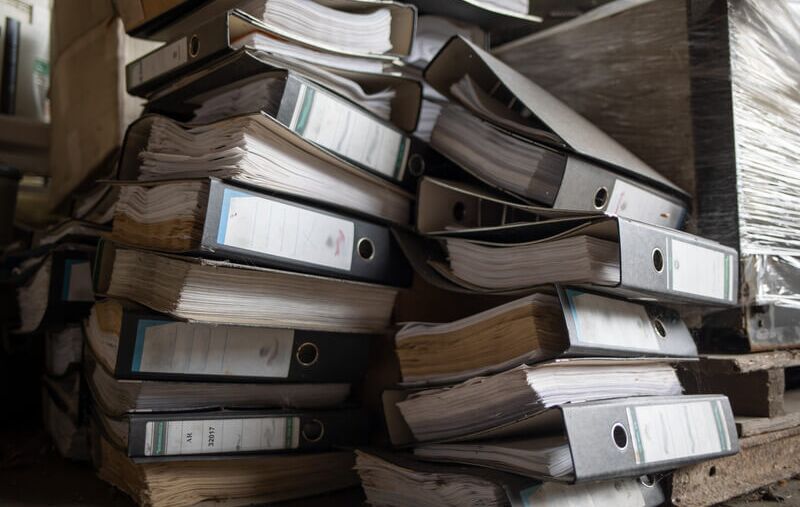SER Blog Customer Stories & Use Cases
The 7-folder system: Organize your electronic files
Businesses today are confronted with more and more documents on a daily basis.Digital filing systems are therefore essential for managing the ever-increasing amounts of data. In this environment, it is important for businesses to set up the digital folder structure systematically and in an organized manner.
The 7-folder system is a proven method that businesses use to store digital files in a clear and comprehensible way so that they are easy to find. In this article, we explain what the 7-folder system is and how it can standardize, organize, and make business processes more productive.

Optimize your folders, optimize your processes
When business go digital, they often make a major mistake by applying their old analog processes and folder structures to digital systems. Yet inefficient processes in paper format will remain inefficient in digital structures.
Businesses have to rethink and transform their digitization processes – and this starts with the filing system. Because the filing system is the basis for all downstream processes. How and where you store your documents determines how workflows are designed and how you add authorization concepts.
We recommend the following: At the beginning of your digital transformation project, introduce useful folder structures and filing systems. This basic system can help you to design end-to-end processes in an optimized and clear manner.
Quickly search through useful folder structures
Clear filing structures prove their worth at the latest when employees are looking for a specific document. This search always takes one of two forms:
-
Using the search function in the document management system (DMS)
-
Using the folder structure
Employees can quickly find the document they are looking for in an organized filing system. Suppose an employee needs a customer invoice from 2023. The employee opens the customer eFile, selects the “Invoices” folder, and clicks the “2023” folder, which contains invoices from that calendar year. The invoice you are looking for is identifiable immediately among the files displayed.
The search is so easy in this example because the folder structure was designed in a useful way. A good method for creating a systematic folder structure is the 7-folder system.
What does the 7-folder system say?
The 7-folder system is an organization method that categorizes files and documents into up to seven main folders. Each main folder contains a maximum of seven subfolders and the seven subfolders are also divided into a maximum of seven areas. The document filing system therefore consists of a maximum of 343 folders.
You can reach each of these 343 folders in one to three clicks.
How the 7-folder filing system works
The following example provides a template for using the 7-folder system:
1. Get an overview of main folders and/or eFiles
Transfer the systematics of the 7-folder system to digital processes and categorize electronic files. The first step is to get an overview of the seven main eFiles that your business needs.
In the example, you categorize your eFiles based on role and subject matter:
-
Customer eFile
-
Employee eFile
-
Supplier eFile
-
Project eFile
-
Case eFile
-
Insurance eFile
-
Building eFile
2. Get an overview of the documents in an eFile
In the second step, you divide each eFile into up to seven subfolders. You can store files in the employee eFile in these seven substructures, e.g.:
-
General information
-
Application documents
-
Minutes from employee meetings
-
Employment contract
-
Pay statements
-
Personal information forms
-
Working hours

DEVK: Process-centric DMS
How DEVK uses Doxis and SAP to streamline its processes, offer first-rate service and protect the personal data of policyholders
Read now3. Develop a folder structure based on the 7-folder system
At this point, you can further develop your digital filing structure based on the 7-folder system. Using the example of the employee eFile, structure the document filing system so that each document has a specific filing location.
The employee eFile is designed on the basis of the subfolders mentioned, for example, as follows:
Employee eFiles
-
General information
-
Employment contract
-
Certificate of good conduct
-
Social insurance
-
Health insurance
-
Health check
Application documents
-
Cover letter
-
CV or resume
-
References
-
Certificates
-
Further training
Minutes from employee meetings
-
Annual reviews
-
Target agreements
-
Professional development plans
-
Exit interview
Employment contract
-
Signed contract
-
Contract data
Pay statements
-
Sickness benefits
-
Salary statements
Personal information forms
-
CV or resume
-
Training and continuing education forms
-
Correspondence regarding personnel matters
Working hours
-
Sick notes
-
Vacation requests
-
Timekeeping records
This is one example of how you can systematically structure eFiles. The folder systems may change, depending on the business purpose, company, and documents you need to manage. It is important, however, that you follow the 7-folder rule diligently to the end. This is the only way to keep the file storage system clear and consistent.
4. Assigning authorizations to documents
Each of the seven electronic files contains sensitive information that is not intended for everyone. You can use authorization concepts to manage the access rights to eFiles and subfolders and make sure that your file storage system is secure.
Different access levels increase data protection:
-
Only employees in HR and line managers may view the employee eFile, in addition to the employee themselves. The eFile remains sealed to everyone else.
-
Only selected people are allowed to access certain subfolders. While the application documents are visible to line managers and recruiters, they remain hidden for those responsible for training and professional development. However, they will see the minutes from employee meetings.
In other words, not only do subfolders serve the purpose of storing documents clearly, they are also important for managing access rights.
Ideally, the 7-folder system is also part of a digital archive, where inactive documents are moved from the filing system to the archive. This ensures that authorization concepts are retained and do not have to be assigned again. This ensures consistent, legally compliant processes between filing and archiving systems, and thus provides audit security for the long term.
Summary: Standardize folder structures with the 7-folder system
With the 7-folder system, you can improve your own folder structure in electronic files. Documents can be quickly found and clearly organized for those authorized to access them. This makes searches more efficient. For this reason, we recommend that you start using consistent standards for filing systems as early as the implementation stages. They help to ensure that you create eFiles that optimize workflows and store documents securely until they are archived.
FAQs about the 7-folder system
The latest digitization trends, laws and guidelines, and helpful tips straight to your inbox: Subscribe to our newsletter.
How can we help you?
+49 (0) 30 498582-0Your message has reached us!
We appreciate your interest and will get back to you shortly.




